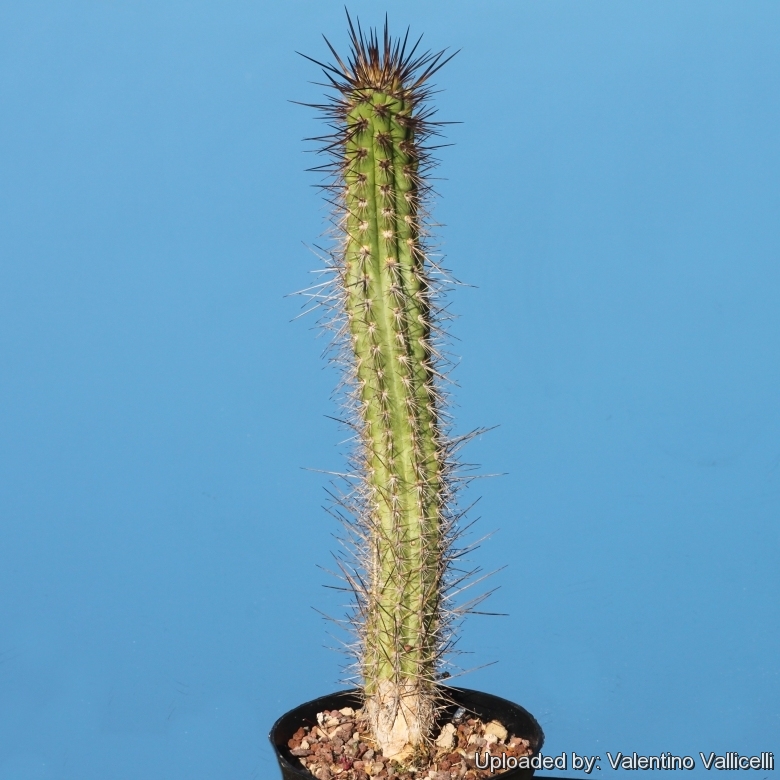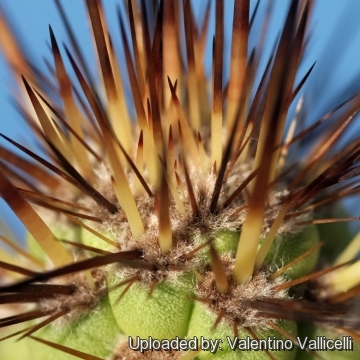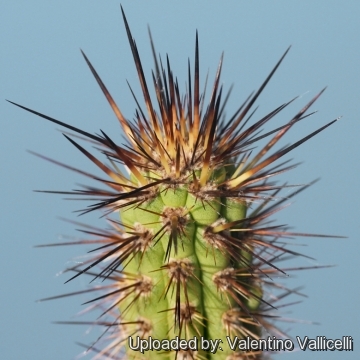




Your support is critical to our success.
Accepted Scientific Name: Eulychnia castanea (K.Schum.) Phil.
Linnaea 33: 80. 1864

Origin and Habitat: Along the coastline from Los Molles north to Talinay, Coquimbo, Chile.
Type locality: Aconcagua.
altitude: 0-500 metres above sea level.
Habitat: It occurs both on flat rocky areas, slopes facing north and ravines along the coast in the Atacama Desert, the driest desert in the world. The climate is very dry with long drought periods of 6-10 months. The precipitations are comprised from 100 to 300 mm per annum and are concentrated in winter, but frequent coastal fog, provides a significant part of its water needs. Eulychnia castaneaSN|7533]]SN|886]] can survive under very hot conditions (temperatures can reach up to 50° C). These areas support rare endemics such as Puya venusta, Puya coquimbensis, Lucurna valparadisiaca, and Carica chilensis, Myrcianthes coquimbensis, and Eulychnia procumbensSN|886]]SN|7533]].
Synonyms:
- Eulychnia castanea (K.Schum.) Phil.
- Cereus castaneus K.Schum.
- Philippicereus castaneus (K.Schum.) Backeb.
Eulychnia castanea (K.Schum.) Phil.
Linnaea 33: 80. 1864
Synonymy: 3
- Eulychnia castanea (K.Schum.) Phil.
- Cereus castaneus K.Schum.
- Philippicereus castaneus (K.Schum.) Backeb.
- Eulychnia castanea cv. varispiralis monstruos form hort.
- Eulychnia monstruosa var. spiraliforme hort.
- Eulychnia spiralis hort.
- Eulychnia varispiralis hort.
- Eulychnia castanea cv. varispiralis cristata hort.
- Eulychnia castanea cv. varispiralis disc shaped form hort.
- Eulychnia castanea cv. varispiralis spiral form hort.
SPANISH (Español): Copado de Philippi, Copao de Philippi
Description: Eulychnia castaneaSN|886]]SN|886]] is a branched shrubby or tree-like succulent plant, hanging down from the rocks on its native hills or spreading from the base with long cereoid stems forming dense thickets sometimes 20 meters broad.
Stem: Cylindrical 50-200 cm long, 6 to 8 cm in diameter, green branching at base ascending at first, later spreading or decumbent.
Ribs: 8-13 low rounded.
Areoles: covered with dark grey felt about 1 cm apart.
Spines: Yellow to brown, straight, often strong unequal.
Radial spines: 6-10 radiating. 5-20 mm long.
Central spines: 1-2, stout, 3-10 cm long.
Flowers: Diurnal, white, borne laterally near tips of branches, small, 5-5,5 long, 4-5 cm in diameter, broadly campanulate; pericarpel tuberculate, tube short, with numerous minute small scales with short brown woolly hairs and slender, stiff, bristly spines 1-1,5 cm long, perianth erect or some-what spreading; tepals 1-1,5 cm long, white or pinkish, tepals. Style short and thick.
Fruit: Globose, up to 5 cm in diameter, fleshy, yellow-green scaly and spiny devoid of bristles except near top; floral remnant persistent.
Seeds: Broadly oval, 1,5 mm black, often grey from the detaching cuticle.
Subspecies, varieties, forms and cultivars of plants belonging to the Eulychnia castanea group
 Eulychnia castanea (K.Schum.) Phil.: has cylindrical stem 50-200 cm long, 6-8 cm in diameter, green branching at base. Spines yellow to brown, straight. Distribution: Los Molles to Talinay, Coquimbo, Chile.
Eulychnia castanea (K.Schum.) Phil.: has cylindrical stem 50-200 cm long, 6-8 cm in diameter, green branching at base. Spines yellow to brown, straight. Distribution: Los Molles to Talinay, Coquimbo, Chile. Eulychnia castanea cv. varispiralis monstruos form hort.: has lumpy-bumpy monstrous surface, this is the more common form.
Eulychnia castanea cv. varispiralis monstruos form hort.: has lumpy-bumpy monstrous surface, this is the more common form. Eulychnia castanea cv. varispiralis cristata hort.: has variously shaped fan-like growths comprising mix of the monstrous, disc shaped and spiral types.
Eulychnia castanea cv. varispiralis cristata hort.: has variously shaped fan-like growths comprising mix of the monstrous, disc shaped and spiral types. Eulychnia castanea cv. varispiralis disc shaped form hort.: has stems formed by green discs placed one on top of another in a heap.
Eulychnia castanea cv. varispiralis disc shaped form hort.: has stems formed by green discs placed one on top of another in a heap.  Eulychnia castanea cv. varispiralis spiral form hort.: has curly, whirly spiral growth that can be equally dextrorotatory or levorotatory.
Eulychnia castanea cv. varispiralis spiral form hort.: has curly, whirly spiral growth that can be equally dextrorotatory or levorotatory.
Notes: The most recent classification is based broadly on the flowers. Eulychia acida has scaly flower tubes. Eulychnia castaneaSN|886]]SN|886]] has hairy and spiny flower tubes. Eulychnia brevifloraSN|7528]]SN|7528]] has very hairy flower tubes and incorporates Eulychnia ritteri and Eulychnia iquiquensis as subspecies. The popular Eulychnia saint-pieanaSN|7535]]SN|7535]] was long ago sunk into Eulychnia breviflora, being a form with especially hairy areoles. There is also a major difference in the overall shape. Eulychnia acida tends to branch from a moderately tall trunk, Eulychnia brevifloraSN|7528]]SN|7528]] from a short trunk, and Eulychnia castaneaSN|886]]SN|886]] from ground level forming low wide bushes.
Bibliography: Major references and further lectures
1) Philip W. Rundel, Gloria Montenegro Rizzardini, Fabian M. Jaksic “Landscape Disturbance and Biodiversity in Mediterranean-Type Ecosystems” Springer, 25/Nov/1998
2) Edward Anderson “The Cactus family” Timber Press, Incorporated, 2001
3) James Cullen, Sabina G. Knees, H. Suzanne Cubey "The European Garden Flora Flowering Plants: A Manual for the Identification of Plants Cultivated in Europe, Both Out-of-Doors and Under Glass" Cambridge University Press, 11/Aug/2011
4) David R Hunt; Nigel P Taylor; Graham Charles; International Cactaceae Systematics Group. "The New Cactus Lexicon" dh books, 2006
5) Clive Innes “Complete Handbook of Cacti and Succulents” Van Nostrand Reinhold Company, 01/Dec/1981
6) Urs Eggli, Leonard E. Newton: “Etymological Dictionary of Succulent Plant Names” Springer, Berlin/Heidelberg 2010
7) N. L. Britton, J. N. Rose: “The Cactaceae. Descriptions and Illustrations of Plants of the Cactus Family.” Volume II, The Carnegie Institution of Washington, Washington 1920
8) John Borg “Cacti: a gardener's handbook for their identification and cultivation” Blandford P., 1970
9) Marticorena, C. & M. Quezada. 1985. “Catálogo de la Flora Vascular de Chile.” Gayana, Bot. 42: 1–157.
10) Zuloaga, F. O., O. N. Morrone, M. J. Belgrano, C. Marticorena & E. Marchesi. (eds.) 2008. Monogr. Syst. Bot. Missouri Bot. Gard. 107: 3 Vols., 3348 p.
11) Klaus Kubitzki, Jens G. Rohwer, Volker Bittrich “Flowering Plants. Dicotyledons: Magnoliid, Hamamelid and Caryophyllid Families” Springer, 30/Jul/1993
12) Curt Backeberg “Die Cactaceae, Handbuch der Kakteenkunde: Volume II: Cereoideae (Hylocereeae - Cereeae (Austrocereinae))” 1959

Cereus castaneus (Eulychnia castanea) Photo by: Valentino Vallicelli

Cereus castaneus (Eulychnia castanea) Photo by: Valentino Vallicelli
Cultivation and Propagation: Considering that Eulychnia castanea comes from a habitat with an extremely arid climate, they are remarkably tolerant of pot culture. These plants are susceptible to overwatering. They requires also an appropriate air circulation. Eulychnia are summer grower species easy to cultivate.
Growth rate: This is a moderately slow growing cactus kept for the beauty of its form that will make clumps given the best conditions.
Soils: It likes very coarse mineral cactus mix soil, but can become too elongated if compost is too rich.
Repotting: Use pot with good drainage.
Watering: It requires light but regular waterings in summer, but let the soil mix dry between waterings, but do not overwater (Rot prone), it must be strictly kept dry throughout the winter quiescent period since it is very sensitive to any moisture excesses keep dry in winter.
Fertilization: Feed with a high potassium fertilizer in summer.
Hardiness: Not highly tolerant of a great deal of frost. They need to be kept in a cool place during winter rest and are resistant to light frost if kept on the dry side prior to, and during, cold weather ( they are hardy to -2 C ° C short periods). However some warmth throughout the year will increase the grower's success (minimum 5° to 10°C during rest season).
Exposition: Requires full sun or light shade and careful watering to keep plant compact with strong coloured spines. Tends to bronze in strong light, which encourages flowering and heavy spine production. Light shadow my be useful in the hottest summer days.
Uses: It is an excellent plant for container growing. It look fine in a cold greenhouse and frame or outdoor in a rockery.
Pests & diseases: It may be attractive to a variety of insects, but plants in good condition should be nearly pest-free, particularly if they are grown in a mineral potting-mix, with good exposure and ventilation. Nonetheless, there are several pests to watch for:
- Red spiders: Red spiders may be effectively rubbed up by watering the infested plants from above.
- Mealy bugs: Mealy bugs occasionally develop aerial into the new growth among the wool with disfiguring results, but the worst types develop underground on the roots and are invisible except by their effects.
- Scales: Scales are rarely a problem. It is wise to treat your whole collection with a systemic insecticide twice a year in spring and autumn.
- Rot: Rot is only a minor problem with cacti if the plants are watered and “aired” correctly. If they are not, fungicides won't help all that much. To prevent rottenness it is also advisable to surround its root neck by very rough sand or grit, this help a fast water drainage.
Propagation: Seeds or offsets. Seeds germinate in 7-14 days at 21-27° C in spring, remove gradually the glass cover as soon the plants will be well rooted (ca 1-2 weeks) and keep ventilated, no full sun for young plants!
| Your Actions | |
|---|---|
| Back to Cereus index | |
| Back to Cactaceae index | |
 |
Back to Cacti Encyclopedia index |
Privacy stantement - Terms and conditions - How to cite - About us - Feedback - Donate




